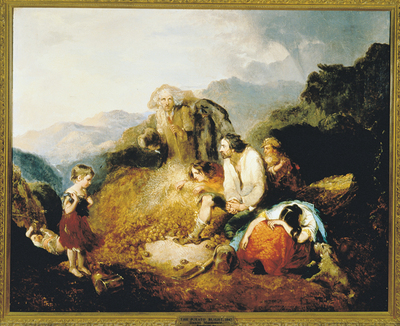In the Lion’s Den: Daniel Macdonald, Ireland and Empire

Daniel Macdonald, An Irish Peasant Family Discovering the Blight of their Store, 1847, 33 x 40″. Image provided by National Folklore Collection, University College Dublin.
Recently, the term “cultural genocide” has been used to decry current global conflicts. This phrase could also be applied to the Great Famine of Ireland (1845–1852), a catastrophe that claimed the lives of more than a million people, displaced another million, and drastically reduced its population. While nobody wants to relive past tragic humanitarian crises, it is important to be informed about them so that they are never repeated. In the Lion’s Den: Daniel Macdonald, Ireland and Empire at the Ireland’s Great Hunger Museum—the only museum to focus on the Famine in the United States—depicts life in Ireland during that watershed period.
On loan from public and private collections in Ireland, the exhibit comprises 21 paintings and pen and ink drawings by Daniel Macdonald (1821–1853). This is the first time American audiences can view a comprehensive exhibition of works by one of the few 19th-century artists to focus attention on the Great Famine. Although largely overshadowed by his contemporaries, Macdonald holds the distinction of having executed the only known painting that directly deals with the subject during the famine itself. The centerpiece of the exhibition, An Irish Peasant Family Discovering the Blight of their Store, portrays the moment of hopelessness when a family realizes they have little food left. Macdonald was only 27 when he completed this work—he tragically died at age 32.
A keen observer of everyday life in Ireland, Macdonald depicts scenes of folklore, superstition, country life and local sport with a combination of idealism and dead-pan irony. As the Famine overtook his country, the verve and farce in his work turns to outrage. Themes of desperation—appalling living conditions, evictions by landlords, and rural violence—decry the inhumanity and degradation of his culture.
In the Lion’s Den is a show of contrasts, spirited windows into a distant past with rites and rituals and a uniquely Irish way of life that was tragically overrun by calamity. These works are foreign yet familiar as the story of Ireland’s “cultural genocide” has been woven into the fabric of America’s heritage.
